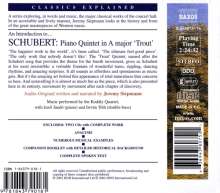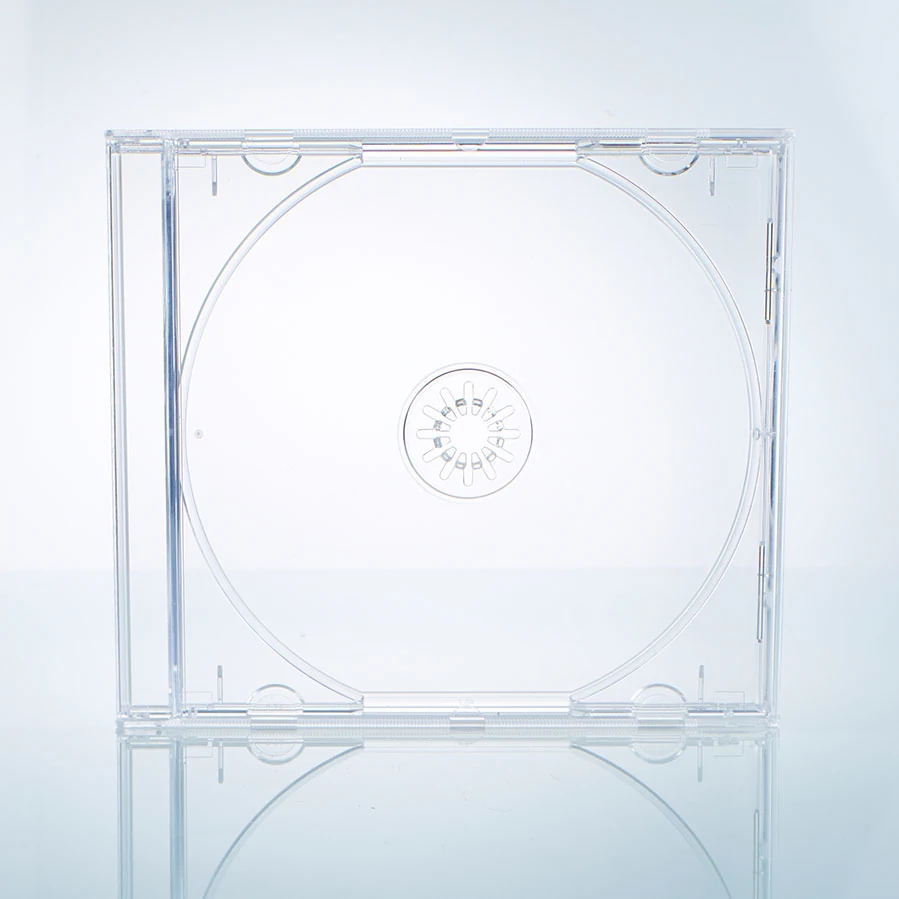Classics Explained:Schubert/Forellenquintett auf 2 CDs
Classics Explained:Schubert/Forellenquintett
2
CDs
CD (Compact Disc)
Herkömmliche CD, die mit allen CD-Playern und Computerlaufwerken, aber auch mit den meisten SACD- oder Multiplayern abspielbar ist.
Derzeit nicht erhältlich.
Lassen Sie sich über unseren eCourier benachrichtigen, falls das Produkt bestellt werden kann.
Lassen Sie sich über unseren eCourier benachrichtigen, falls das Produkt bestellt werden kann.
Eine Werkeinführung in englischer Sprache mit einem 120-seitigen Booklet. Autor & Sprecher: Jeremy Siepmann
- Künstler:
- Jando, Toth, Kodaly Quartett
- Label:
- Naxos
- Aufnahmejahr ca.:
- 2001
- UPC/EAN:
- 0636943807521
- Erscheinungstermin:
- 14.10.2002
Ähnliche Artikel
Disk 1 von 2 (CD)
-
1 Introduction, origins
-
2 Imagery, analogy and the shape of the things to come; the opening flourish
-
3 The unusual presence of the double-bass
-
4 A palette of tone colours and the emergence of a theme
-
5 Trouble getting off the ground, but the key is not in doubt.
-
6 Jumping in queue: Schubert takes a lesson from Mozart.
-
7 Mozart demonstrates a traditional transition.
-
8 Destinarion clarified
-
9 Mozart confirms our arrival.
-
10 A Schubertian shocker from a later work
-
11 Rejoining the "Trout"; with a reminder
-
12 The piano joins the strings with yet a third variant of the theme.
-
13 A rhythmic motto: The "triplet motif"
-
14 We get it here.
-
15 We get it there.
-
16 We find it everywhere, even in the double-bass.
-
17 The strings' answer to the piano's opening flourish
-
18 The two-part structure of the "answering motif"...
-
19 ... but scarcerely ever the same way twice
-
20 The piano and strings now share the material for the first time.
-
21 Conversation as the first principle of chamber music
-
22 Opening (indrocutory) section heard complete
-
23 The violin and double-bass in partnership
-
24 The violin and piano swap roles.
-
25 Transition to second main theme; triplets now everywhere
-
26 On the threshold of the new theme
-
27 Second main theme (a "love duet"), shared by cello and viola
-
28 The abandonment of octaves in the piano changes the tone colour.
-
29 A surprising change of tone and a premonition
-
30 A return to lyricism, but the cello jumps the gun
-
31 A buoyant, skipping new theme is given to the solo piano.
-
32 Re-entry of the strings as the violin takes up the new theme
-
33 A transitional theme, and another Schubertian key-jump
-
34 We sense the imminent arrival of the closing theme.
-
35 A sudden, hushed key-change introduces part two of the closing theme.
-
36 The exposition comes to an end.
-
37 Cue to complete exposition
-
38 Music: Exposition complete
-
39 Introduction to the development; the genetic code of "key"
-
40 The contrasting aural properties of piano and violin
-
41 The ponderous double-bass is deatured in the first main theme
-
42 The strings are liberated from servitude, but are a long way from home.
-
43 A joyful conversation and a change of pace in the piano
-
44 The piano takes the melodic lead again.
-
45 A conversation between violin and piano leads to the exposition
-
46 ... But Schubert gets it "wrong".
-
47 Music: First movement (Complete)
-
48 Introduction to second movement
-
49 The violin now takes theme one.
-
50 The piano regains the theme.
-
51 The violin and piano round off first section with the new "closing" theme.
-
52 A major change of tone: A passing cloud and a dark new key
-
53 The piano abandons its octaves, but not its triplets, in the new "Hungarian" theme.
-
54 The Sun returns with a new theme, in two contrasting parts.
-
55 An evaporating dialogue between violin and piano
-
56 A major mood change as twilight falls
-
57 Cue to whole movement
-
58 Music: Second movement (Complete)
Disk 2 von 2 (CD)
-
1 Introduction to the Scherzo - and a clear four-bar phrase...
-
2 ... "Answered" by two two-bar phrases
-
3 A disconcerting "echo"
-
4 Expectation, frustration and surprise
-
5 The phrase lenght expands from nine to fourteen bars
-
6 The beginning of the second half...
-
7 ... Or should it go from g minor to D major?
-
8 Doubts are sown as the tonality becomes elusive.
-
9 A varied reprise of part one, and the end of the Scherzo proper
-
10 A conversational start to the Trio section
-
11 Another Schubertian phrase extension
-
12 Two overlapping phrases add up to a single theme.
-
13 The piano adds a third phrase to the overlap.
-
14 The overlaps continue as the key drifts downwards.
-
15 Another Schubertian key-jump, now to B flat
-
16 A dramatic transformation of mood
-
17 Awakening from a dream: The main theme's return
-
18 Cue to complete Scherzo
-
19 Music: Third movement (Complete)
-
20 Enter the trout, at last; a meeting with the original
-
21 Music: "Die Forelle"
-
22 Back to the Quintet: The strings, headed by the violin, introduce the theme.
-
23 The first variation
-
24 The second variation
-
25 The third variation
-
26 The fourth variation, part one
-
27 The fourth variation, part two
-
28 The fifth variation
-
29 The final variation, part one: Violin and piano alone introduce the theme.
-
30 The final variation, part two: The cello takes the tune.
-
31 The final variation, part three: Piano and violin return as a duo...
-
32 The final variation, part four: ... As do the viola and cello.
-
33 The final variation, part five: The entire ensemble is reunited.
-
34 Music: Fourth movement (Complete)
-
35 Introduction to the finale: Schubert as wizard of repetition
-
36 Easily overlooked: The accompaniment from cello and double-bass
-
37 Contrasts of timbre and register
-
38 A repetition, and yet not a repetition
-
39 A journey begun; the phenomenon of musical gravity
-
40 The journey completed
-
41 The source of musical gravity
-
42 Music: Saint-Saëns - The Carnival of the Animals "The Pianists"
-
43 A scale of shifting tensions
-
44 Music: Beethoven, Symphony No. 1 (Finale)
-
45 Back to Schubert
-
46 The piano embellishes a scalewise descent.
-
47 A retrospective moment
-
48 Repetition more apparent than real
-
49 A taste of phrase rhythm
-
50 Shifting patterns of accentuation
-
51 The section reviewed
-
52 An increasingly sophisticated texture as parts interact
-
53 More phrase rhythm
-
54 A repetition from the strings...
-
55 ... And an answer from the piano
-
56 In transition to the secondary key
-
57 The origin of the second theme
-
58 The second main theme
-
59 The closing section begins, with a question answered.
-
60 The question repeated, a slightly different answer
-
61 First theme of closing section reviewed
-
62 Remembrance of things past
-
63 The piano and strings argue over the harmony.
-
64 Emergence of the final theme
-
65 An unecpected thunderstorm
-
66 The sound of silence
-
67 Cue to complete finale
-
68 Music: Finale (Complete)







